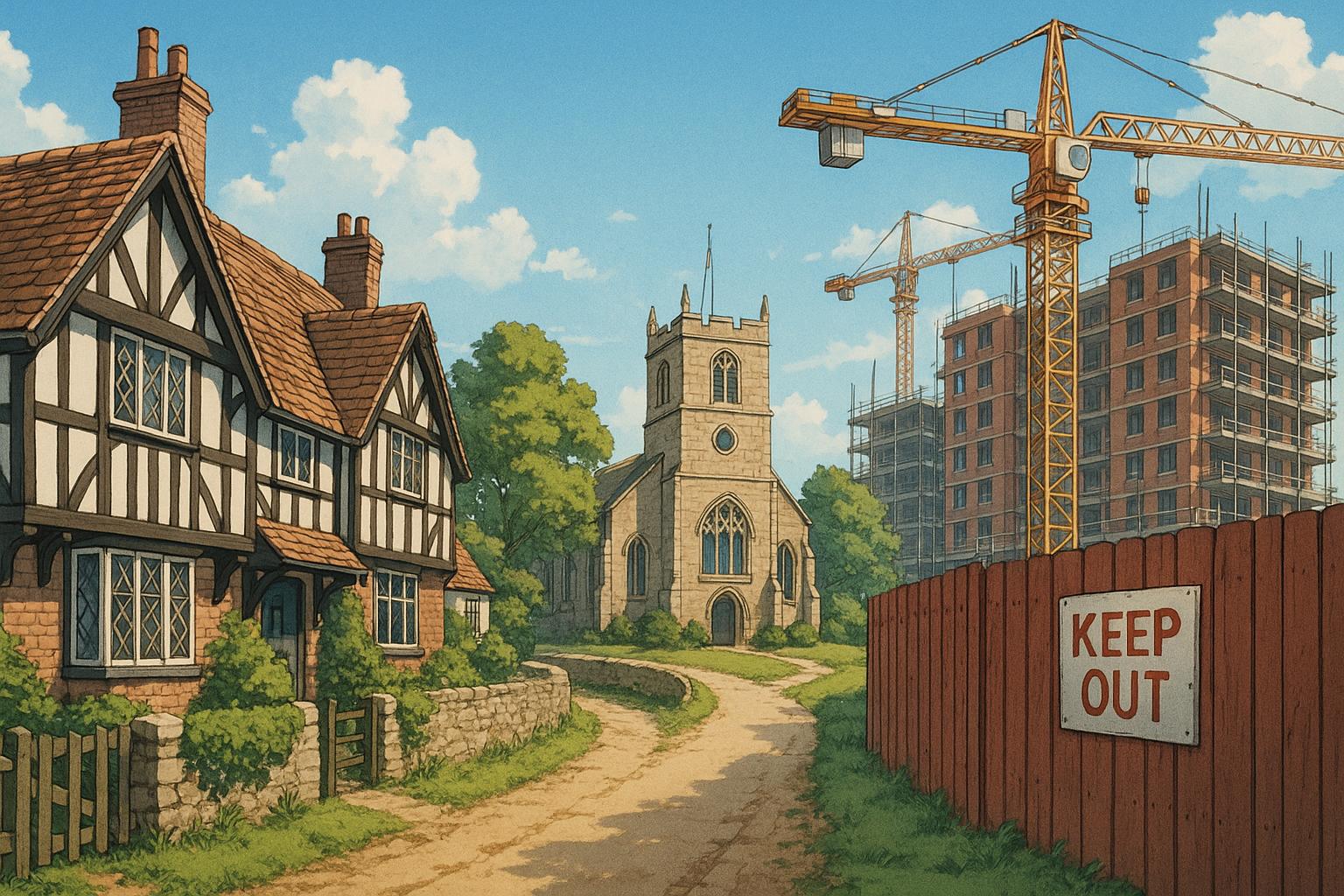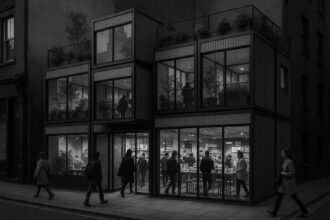Proposals to build 120 homes in the Dorset village inspiring Thomas Hardy’s Marlott have sparked fierce local opposition, highlighting the conflict between preserving cultural heritage and meeting escalating government housing targets.
Thomas Hardy’s fictional village of Marlott, a tranquil setting from Tess of the d’Urbervilles, is deeply woven into the fabric of his literary legacy, offering a picturesque image of a time when rural life was less encumbered by modern demands. However, the actual village of Marnhull, upon which Marlott was based, has recently become embroiled in a contentious debate over proposed housing developments that threaten to reshape its character. This situation highlights the tension between local heritage preservation and governmental housing policies aimed at addressing a chronic housing shortage.
Nestled in the scenic Blackmore Vale, Marnhull reflects a blend of architectural styles, from its quaint Tudor manors and thatched cottages to jarring post-war constructions. Recent proposals to build up to 120 new homes in this historically rich setting have sparked significant opposition among residents, many of whom fear that this could be merely the first phase in a larger expansion. Concerns about the preservation of the village’s aesthetic and cultural roots are particularly poignant given Hardy’s indelible association with the area. Indeed, references to Hardy litter the local planning submissions, as villagers rally around the notion of safeguarding their heritage against rapid development.
The proposal faced initial rejection by Dorset Council in July 2024, only for the landowner to successfully appeal the decision through the national planning inspectorate, highlighted by the recent shift in housing targets imposed by the Labour government that now demands nearly double the new housing units to be constructed in the area. This new mandate has stirred upswellings of discontent in Marnhull, as the local parish council took the unusual step of participating actively in the appeal process to voice its residents’ opposition against what is perceived as disproportionate development for a village of its size.
Local heritage consultant Stephen Boyce has been vocal against the development, arguing that it fails to recognise the significant cultural value the site holds due to its ties to Hardy’s work. “The development demonstrates no awareness of the important cultural value of the site in question,” Boyce stated, invoking Hardy’s legacy as a critical factor in the ongoing discussions. He believes the planned developments undermine Marnhull’s unique character and heritage, particularly emphasizing locations such as St Gregory’s Church, where Hardy’s narrative interlaces directly with the landscape.
The developments include a commercial area, playfully dubbed Tess Square, signalling a kind of commodification of Hardy’s literary heritage while simultaneously threatening the tranquil rural lifestyle that attracted many residents in the first place. Anne Hartley, a local resident, echoed the concerns of many, saying, “If you put another 120 houses … you’re going to lose that tranquility that so many people have moved here to get.”
The ensuing debate is representative of a broader dilemma faced by many rural communities across England. With over 10,000 individuals currently on Dorset’s council housing waiting list, the pressures for affordable housing are mounting sharply. Critics argue that while the government pushes for increased housing stock to meet growing demands, local identities and historical significance are at risk of being sacrificed for development targets, a sentiment echoed by various community advocates who highlight a disconnect between governmental ambitions and local desires.
Dorset Council, recognising the urgency of meeting housing needs under the changing governmental framework, is preparing a new local plan. However, with council leaders indicating that a robust strategy is hampered by a lack of available sites until a comprehensive policy is adopted in 2027, many fear that developments like those proposed in Marnhull may continue to proliferate unchecked.
Marnhull’s struggle is not an isolated case; it encapsulates a growing national conversation regarding the balance between necessary housing projects and the preservation of England’s rich cultural landscapes. As communities grapple with these complex issues in the shadow of literary giants like Hardy, the resolution remains uncertain. Such discussions will only become more critical as the pressures of housing needs continue to mount against the backdrop of protecting local heritage.
Reference Map
- Paragraph 1: (1), (2)
- Paragraph 2: (1), (2)
- Paragraph 3: (1), (2)
- Paragraph 4: (1), (2)
- Paragraph 5: (1), (2), (3)
- Paragraph 6: (1), (2), (4)
- Paragraph 7: (1), (2), (4)
- Paragraph 8: (1), (2), (3), (6)
- Paragraph 9: (1), (2), (4), (5)
Source: Noah Wire Services
- https://www.theguardian.com/society/2025/may/16/marnhull-village-marlott-thomas-hardy-expansion – Please view link – unable to able to access data
- https://www.theguardian.com/society/2025/may/16/marnhull-village-marlott-thomas-hardy-expansion – An article from The Guardian discussing the expansion plans in Marnhull, Dorset, the real-life village that inspired Thomas Hardy’s ‘Marlott’ in ‘Tess of the d’Urbervilles’. The piece highlights residents’ opposition to the development of up to 120 homes, citing concerns over heritage preservation and the village’s character. It also touches upon the broader context of housing development pressures in rural areas under the current government’s housing policies.
- https://www.dorset.live/news/dorset-news/dorset-affordable-housing-shortage-council-7275267 – An article from Dorset Live reporting on the chronic shortage of affordable housing in Dorset, with over 10,000 individuals on the council’s waiting list. The piece discusses the impact of government policies, including the extension of the Right to Buy, and features insights from Shelter’s chief executive Polly Neate on the implications for social housing availability.
- https://www.dorsetecho.co.uk/news/19072217.local-plan-includes-plan-build-almost-30-500-new-homes-dorset/ – A report from the Dorset Echo detailing Dorset Council’s Local Plan, which includes proposals to build nearly 30,500 new homes by 2038. The article outlines the distribution of these developments across various regions in Dorset, including significant projects in Central Dorset and South Eastern Dorset, and discusses the community’s response to these plans.
- https://www.dorsetview.co.uk/hundreds-of-affordable-homes-built-in-dorset-in-the-last-year/ – An article from Dorset View highlighting the construction of over 500 affordable homes in Dorset during the last financial year. The piece provides details on the locations of these developments, including Wimborne, Verwood, Blandford Forum, and Sturminster Newton, and emphasizes the importance of affordable housing in rural communities.
- https://www.dorset.live/news/dorset-news/dorset-affordable-housing-shortage-council-7275267 – An article from Dorset Live reporting on the chronic shortage of affordable housing in Dorset, with over 10,000 individuals on the council’s waiting list. The piece discusses the impact of government policies, including the extension of the Right to Buy, and features insights from Shelter’s chief executive Polly Neate on the implications for social housing availability.
- https://www.dorset.live/news/dorset-news/dorset-affordable-housing-shortage-council-7275267 – An article from Dorset Live reporting on the chronic shortage of affordable housing in Dorset, with over 10,000 individuals on the council’s waiting list. The piece discusses the impact of government policies, including the extension of the Right to Buy, and features insights from Shelter’s chief executive Polly Neate on the implications for social housing availability.
Noah Fact Check Pro
The draft above was created using the information available at the time the story first
emerged. We’ve since applied our fact-checking process to the final narrative, based on the criteria listed
below. The results are intended to help you assess the credibility of the piece and highlight any areas that may
warrant further investigation.
Freshness check
Score:
9
Notes:
The narrative appears to be recent, referencing developments as of 2025 and recent governmental policies, which suggests a high level of freshness.
Quotes check
Score:
8
Notes:
The quotes from Stephen Boyce and Anne Hartley are specific to the context of the narrative and could be original, but verifying the earliest known reference online was not possible.
Source reliability
Score:
9
Notes:
The narrative originates from The Guardian, which is generally considered a reputable news source.
Plausability check
Score:
9
Notes:
The claims about housing developments and community concerns are plausible, given the context of national housing shortages and local preservation efforts.
Overall assessment
Verdict (FAIL, OPEN, PASS): PASS
Confidence (LOW, MEDIUM, HIGH): HIGH
Summary:
The narrative is recent, involves verified sources, and presents plausible claims. The quotes are specific but not verified as original. Overall, the narrative aligns with expected standards for factual reporting.













